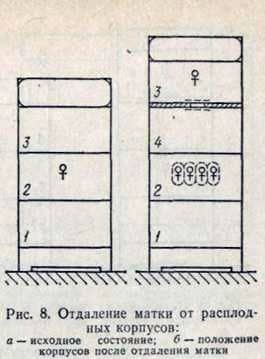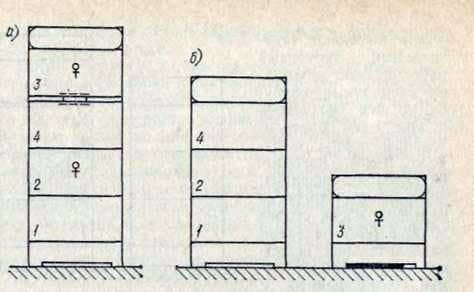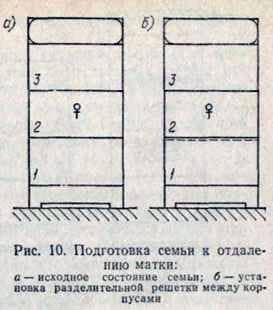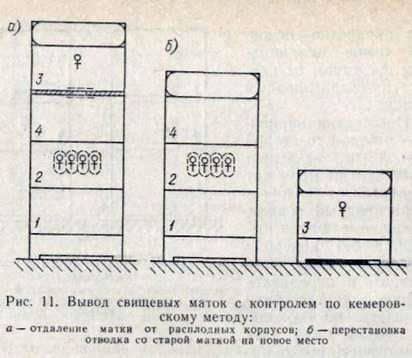
The work is carried out on June 5-8, during the flowering period of gardens and yellow acadia, in order to eliminate swarming and the simultaneous replacement of two-year-old queens in half of the families. In the next 3-4 weeks, the apiary can not be visited.
The change in two-year-old queens is due to the fact that by the end of May or in June they reduce oviposition, their productivity in comparison with annuals falls by 30-40%. It is known that families with similar uterus have an increased rile. When these queens are replaced, the most productive ones are used, and during the swarming period the most non-ripe single-season and one-year-old queens are provided.
The basis for the work is a slightly modified reception of Demari of the distance of the brood from the uterus with only its partial isolation.
Uterus with two honeycombs, having an open brood and bees, is transplanted into the third body. From the building
frames, a sealed drone brood is cut out. Bottom place the brood bodies, but already without the uterus and one more separation body with a dry land. Above is the ceiling-diaphragm, the central opening of which on both sides should be sealed with a dividing grid, and open the chute, combined with the upper hole in the wall of the pavilion.
He is put on a hull with a uterus and a layer, whose summer bees (after their appearance) and will use an open in the ceiling for a flier.

In the lower cases, the bees lay the fistula queen cells and remove the queens, leaving themselves one of the best.
Lapping with the old uterus after the laying of queen cells in the lower hulls (in 4-5 days) can be rearranged to a new place, placing in them 2-3 honeycombs with a printed brood from undefined families with annual uterus. The summer in the upper case in this case can not be opened.
When the uterus is separated from the small family from the main family, it should be borne in mind that the degree of its isolation determines the behavior of the bees in the remainder of the family. Isolation with an empty shell with a drywall and wire dividing grid is the “softest”, and if the uterus is strong, the bees sometimes do not feel its absence in the lower hulls and do not lay queen cells.
In this case, it is necessary to replace the wire grating with a stamped one, which provides a greater degree of insulation, or to put a diaphragm with a hole on both sides embedded with a stamping dividing grid. In the latter case, the bees lay queen cells in the lower hulls without setting up an additional hull with a sushi.

Fig. 9. Rearrange the layer with the old uterus to a new location; a – the initial state of the family; b-position of the bodies after rearrangement

At the same time, applying excessive isolation of the uterus, for example, when the hole in the ceiling is small, the bees can behave the same way as in full isolation or selection, that is, they will lay many queen cells on any larvae. By its condition, the family will not differ from the orphaned, which can not be allowed.
When two uterus will work in the family, in other words, if the old uterus is not repositioned to a new location, the upper housing with the old uterus and the printed brood is taken away, and the remaining bees and broods are united. The united family, deprived of the printed brood, is treated with oxalic acid.
Treatment of the family with a young uterus is necessary to be carried out at the indicated time, since earlier in the lower part of the family there may still be an unreachable drone brood, and later there may appear four-day larvae from the young uterus, into which cells the tick could already get.
This option requires little labor and time, but allows you to exclude the natural swarming, replacing it with artificial, conducted in the right period. In this case, at the time of the main honey harvest, the oviposition of the uterus is limited to one body; a change in the uterus is ensured, and an additional family is obtained from the lap with the old uterus without weakening the main; the effective treatment of the main family with an acaricidal agent from a tick in a no-fertilizing period is performed.
Disadvantages of the variant – the broods with the old uterus and the printed brood, do not undergo treatment from the tick in a no-fertilizing period, and the fistulas are removed without the control of the beekeeper, because of which it is undesirable to select and transfer unnecessary to other families, since the bees need to be given a choice.
The separation grid is placed between the brood bodies, and if there is no third honeymoon, it is placed with honeycomb honeycombs and 3-4 frames of honeycomb.
Three days after this, the body 3 must be placed next to the hive, to drive all the bees out of the hull with the uterus, without trying to find it. The body with the uterus is determined by one-day eggs, which stand on the bottom of the cells vertically. If the uterus is still found, then it must be transferred together with the honeycomb into the third body and add another honeycomb with the presence of an open brood.
If the uterus is not found, then after the bees are removed from the brood body, two honeycombs with bees and an open brood should be transferred to the uterus, marking them with clerical buttons. Then it is necessary to cut out the tartar brood from the building honeycombs.
Fertile bodies remain below, and the body with one-day eggs, where the uterus was placed, is placed second, then the body with the sushi, then a separating grating or diaphragm with a barred hole is immediately placed. They put a body with a uterus on them. An additional body serves to distance the brood from the uterus.

Bees through the dividing grid (as in the first version) are distributed between the bodies. In housing with brood bees lay queen cells.
After 4 days, the body with the uterus should be put in a new place. In the lower, brood body, all queen cells must be destroyed, if any, in the upper – leave the 4-5 best, with the youngest larvae floating in milk, preferably on different honeycombs. These cells are also usually labeled with clerical buttons.
Manipulating the frames on which queen cells or broods are found, it must be remembered that it is impossible to expose these honeycombs to impacts, turn them over or shake the bees, it is better to sweep them with a brush, a wing or a bunch of grass. Impacts can lead to the death of larvae and pupae, bees and queens.
From the brood body of the honeycomb with brood (marked with buttons), without bees, they are rearranged to the housing shells, replacing them with honeycombs with 1 liter of syrup, since this brood will not have flying bees for 6-7 days.
On the brood shells we must put the case with empty honeycombs, which used to be used for the removal of the uterus.
Bee with the uterus treated with folbekse or other acaricides, placing them in a new place and adding them
for 2-3 honeycombs with brood from undefined families.
After 4 days after the first examination, the mothers should be resubmitted in size and shape, leaving large (at least 20 mm long), properly rebuilt. All queen cells, pledged in addition, destroyed. The lower, brood body is not required to be inspected for the second time, since the queen cells can no longer be there.
In this version, excess queen cells (if they are bred in a breeding family) can be used for substitution in other families with the purpose of organizing layers with reserve mats, considering that the quality of almost all the uterus obtained from them is high. The queen cells are selected on the 11th to the 12th day after the separation of the uterus from the brood and put them into other families, providing replacement of the queens or queen cells of these families for queen cells from the breeding family.
After the ripening of the queen cells from the non-deferred families, pre-selection layers can be formed to expand the apiary. Then I select from them 2-3 honeycombs with a sealed brood and bees, making sure not to transplant the uterus into the brood. Lapping is formed in 2 buildings on 4 frames of a sealed brood with bees, I put in it a mature motherhood or, more conveniently, a honeycomb with a mother liquor, instead of which I put a honeycomb with a printed brood from a non-family family. The brood and honeycomb with the mother liquor are sent to the upper case, which I add along the edges of the honeycomb with the presence of perga. In the lower case are 6-7 empty honeycomb, which pour 1 liter of syrup.
In this state, the lapping offtake is closed for 4-5 days, adding to the honeycombs of the lower body two days later to the third per liter of syrup. After the exit and maturation of the uterus, the flap opens.
This mode of formation of layers leads to the fact that even old bees do not fly from it, which during this time are included in the processing of the syrup. In the future, it is useful to give such a syrup to the honeycombs of the lower hull or feeder before the flight bees appear from the whole of the printed brood, that is, within 10-12 days.
The presence of fetal queens allows to preserve the order of formation of the layers, but the uterus is attached to a honeycomb with honey cells under a large cap and is released in a day or two, depending on the ratio
Niya to her bees is a snare. Before the release of the uterus, you need to make sure that the fibrillar cells are not laid in the lap, and if they are found, they must be destroyed. In this case, the uterus is released in 2-3 hours after the destruction of fistula mother cells, piercing the honeycomb under the cap with a pencil.
Care for the rest of the families is the timely expansion of the hive volume with additional hulls with combs and honeycomb (the same dates), selection of 2-3 frames of printed brood to strengthen the layers with old uterus and the formation of new families.
The absence of the separation grid under the third (honey) body does not help the uterus to enter it more often and stay there. In the presence of honey, Middle Russian and Carpathian bees push it into the lower shells, trying to put honey in the upper part of the hive, away from the tap.
Work number 5 (second option) is carried out 26-30 days after the brood separation from the uterus, that is, in early July. Part of the family (in which the uterus was excreted) is treated with oxalic acid, permitted for use during the honey harvest.
If the litter with the old uterus is left at the top and separated from the main family by a continuous plywood bottom, which can be tolerated in the course of the work, having good honey collection in July, then it must be moved to a new location, ensuring the transfer of the flying bees of this lap to a family with a young uterus.
The treatment of bees with oxalic acid in this case is carried out on the next day after the bees are removed from a layer with an old uterus in a family where the uterus is young.
A family with a young uterus, strengthened with flying bees, the laying of the second honey hull, checking the laying of eggs with a young uterus. If she does not have enough egg laying, she lays eggs with missing cells, then the old uterus should be returned to the family along with the cut-off.
On the lead, rearranged to a new location in June, it is required to put the 2-nd building with the rearrangement there of 5-6 frames from the layer, 1/2 or 1/3 occupied with honey. In the lower body of the layering put honeycomb (instead of rearranged) for the build-up of bees and pear honeycombs.
In early August, the number of frames in the body of the layers should be reduced to the required for wintering (
7-8 pieces in each), leaving free space on one side of the shells.
Family with a young uterus, if there is honey and spray in all honeycomb honeycombs, put a new housing with free honeycombs under the available honey.
Черные соты. Опыты с пчелами.
Contents of bees in the pavilion